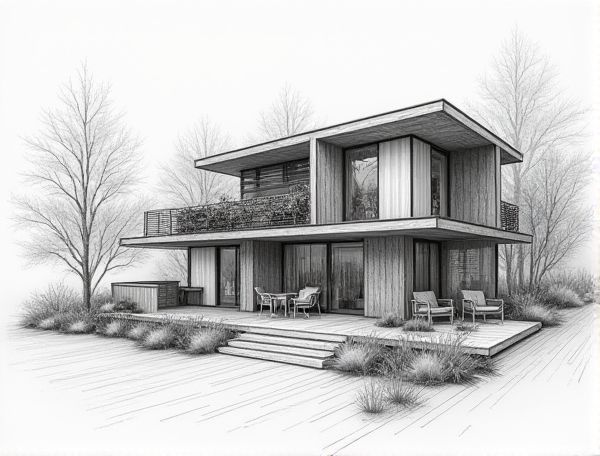
Photo illustration: Biophilic home design with integrated vertical gardens
Biophilic home design with integrated vertical gardens enhances indoor air quality and creates a soothing oasis by bringing nature directly into your living space. Discover how incorporating these green walls can transform your home environment by reading more in the article.
Introduction to Biophilic Home Design
Biophilic home design integrates natural elements like sunlight, plants, and organic materials into your living spaces to enhance well-being and reduce stress. Incorporating features such as natural textures, greenery, and water elements creates a harmonious environment that boosts creativity and improves air quality.
The Science Behind Biophilia and Well-Being
Biophilia, the innate human connection to nature, significantly enhances well-being by reducing stress, improving air quality, and boosting mood through natural elements in home design. Incorporating plants, natural light, and organic materials into Your living space fosters a healthier, more balanced environment that supports mental and physical health.
Benefits of Integrating Vertical Gardens Indoors
Integrating vertical gardens indoors enhances air quality by naturally filtering pollutants and increasing oxygen levels, promoting a healthier living environment. This space-saving design solution also improves aesthetic appeal and boosts mental well-being through exposure to greenery and natural elements within home interiors.
Essential Elements of Biophilic Interiors
Incorporating natural materials like wood, stone, and plants enhances your home's biophilic design by fostering a strong connection to nature. Maximizing natural light through large windows and skylights improves air quality and mood, promoting well-being. Integrating organic shapes and natural colors creates a soothing environment that supports relaxation and productivity.
Choosing the Right Plants for Vertical Gardens
Selecting the right plants for vertical gardens involves considering factors such as light exposure, humidity, and maintenance requirements. Succulents, ferns, and trailing vines like pothos thrive in vertical setups due to their adaptability and low water needs. Incorporating a mix of evergreen and flowering species enhances aesthetic appeal while promoting biodiversity and air purification.
Innovative Vertical Garden Systems for Homes
Innovative vertical garden systems for homes maximize space utilization by integrating modular panels with advanced hydroponic technology, promoting sustainable urban living. These systems enhance air quality and aesthetic appeal while enabling year-round cultivation of herbs, vegetables, and ornamental plants indoors. Smart irrigation and automated nutrient delivery features optimize plant growth, reducing maintenance time and water consumption significantly.
Natural Lighting and Irrigation Solutions
Maximize natural lighting by strategically placing large windows and skylights to reduce energy consumption and enhance your living space's ambiance. Incorporate efficient irrigation solutions such as drip irrigation systems and rainwater harvesting to maintain lush gardens while conserving water and lowering utility costs.
Maintenance Tips for Healthy Indoor Vertical Gardens
Regularly inspect your indoor vertical garden for pests and diseases to prevent infestations and maintain plant health. Implement a consistent watering schedule suited to the specific plant species, ensuring proper drainage to avoid root rot and fungal growth. Use natural fertilizers and prune plants periodically to promote growth and enhance air circulation within the vertical garden structure.
Biophilic Home Design: Real-Life Case Studies
Biophilic home design integrates natural elements like plants, natural light, and organic materials to enhance well-being and energy efficiency, as demonstrated in real-life case studies from urban homes in Seattle and rural retreats in Costa Rica. These projects showcase how incorporating greenery, water features, and natural ventilation can transform your living space into a healthier, more harmonious environment.
Future Trends in Biophilic and Sustainable Living
Future trends in biophilic and sustainable living emphasize integrating natural elements and energy-efficient technologies into home design, promoting health and environmental responsibility. Smart home systems that optimize natural light, ventilation, and renewable energy sources enhance sustainability while creating harmonious living spaces. Your home can become a sanctuary that prioritizes eco-friendly materials and supports well-being through seamless indoor-outdoor connections.
 homedesy.com
homedesy.com